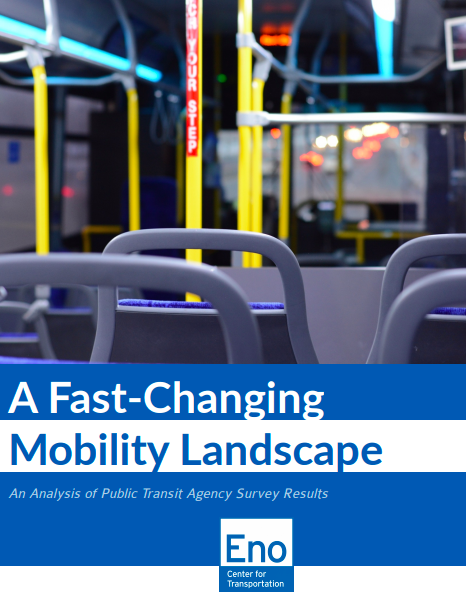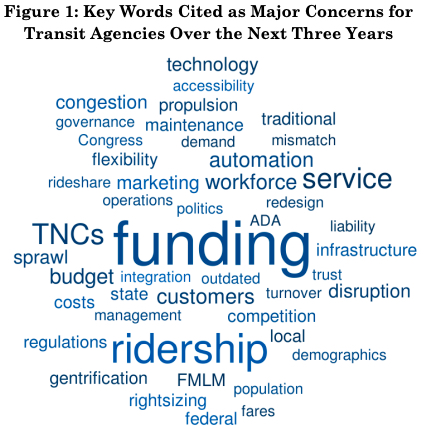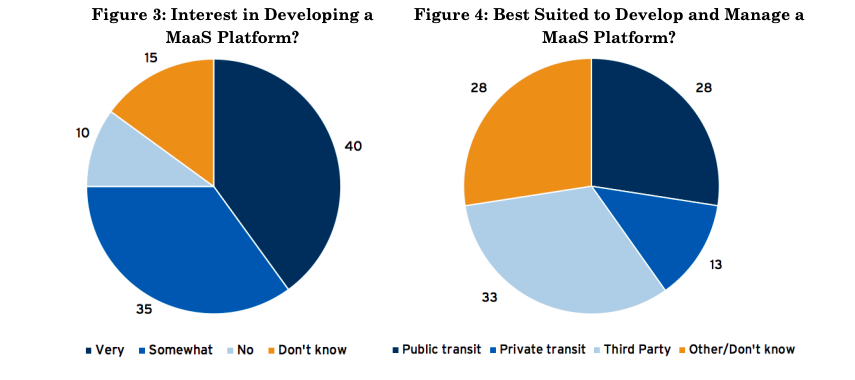ENO CENTER FOR TRANSPORTATION
 Cities, states, and metro areas throughout the United States are going through a period of profound change and transition that is having enormous impacts on public transit.
Cities, states, and metro areas throughout the United States are going through a period of profound change and transition that is having enormous impacts on public transit.
Demographic and cultural changes now alter the very function and purpose of our transportation network and whom it is serving. At the same time, disruptive technology is being deployed throughout the built environment that enables greater efficiency, new actors, and more mobility options. And, of course, we are going through a period of profound political and institutional change challenging notions for the role of government in the transportation sector. These forces affect how we travel, how information is shared, how public agencies manage and invest in transit, and how private firms engage.
To better understand these effects, Transdev, an international private-sector transport operator, commissioned a survey by Ipsos, a market research consultant, to gauge the challenges transit agencies face as well as their expectations of private sector transport operators. The survey of transit officials began with an open-ended question about their primary concerns over the next three years, followed by specific questions regarding their attitudes towards the deployment of new technology, partnerships, and customer service, among others.
This summary was prepared independently by Eno. It does not report on every element of the survey but is organized around several key themes that emerged as a result of an analysis of the results:
1) Notable challenges in the next three years include a lack of resources; primarily funding and workforce needs.
Transit agencies depend on federal, state, and local dollars for both capital and operational funds. The uncertainty and insufficiency of public funding is nothing new and 61 percent of respondents noted that the lack of fiscal resources as a main public transit challenge in the next three years. These included specific responses such as budgetary concerns, cases where expenses are outpacing revenue, lack of dedicated revenue, and unpredictable local funding. Funding challenges were reported as a particular concern for small agencies and those that provide paratransit services.
A small but notable number of respondents—about 12 percent—also mentioned challenges related to retaining, developing, and attracting agency workforce. This included both hiring vehicle operators, as well as concerns around succession planning and finding experienced transit professionals to fill vacancies expected as more senior management personnel reach retirement age. A recent analysis from Los Angeles Metro found that over 70 percent of that agency’s workforce is over age 40 and within five years of retirement. A comprehensive 2017 survey of transit agencies found similar results. Nationally, 90 percent of bus operators are over 40 years old as are 75 percent of bus maintenance workers. Many of these workers were hired when public transit agencies were created in the mid-1960s through the early 1990s, and after the first wave of retirements 35 years or so later, agencies struggled to fill positions ever since.
Issues of funding and workforce are closely interrelated. According to the American Public Transit Association, salaries and benefits for the people who operate and maintain transit vehicles are typically agencies’ single largest operating expense: about 62 percent. Survey results show only 12 percent of respondents said they were very likely to reduce the cost of public transit, even if it meant service cuts. Here there are clear splits between small and large agencies. Over 40 percent of small agency respondents said such cuts were very or somewhat likely while only 20 percent of those from large agencies did. There were interesting geographic splits, as well, especially between Northeastern (71 percent) and those in the West (24 percent).
That matters today because of the interest in contracting out transit service to private entities also known as competitive tendering. A recent report from Eno and Transit Center found that when contracting is done just to save money, transit agencies wind up devising poor contracts, chasing the lowest bidder, and undercutting workers. The result is often substandard service. It also creates an upheaval for the workers whose skills are essential to delivering high-quality service. However, when implemented carefully, it can improve performance and support agency cost-efficiency while preserving essential labor protections.
2) Agencies recognize that to overcome their challenges, they must focus on their core mission: better serving their customers.
 Customer satisfaction is a primary driver of whether or not people choose public transit over other travel options. Unsurprisingly, almost every respondent (98 percent) noted one of their agency’s goals is to improve the overall passenger experience. The same share emphasized improving safety and security as a primary goal. Nearly as many (93 percent) said their agency was likely to enhance the courtesy and empathy of staff and instill a stronger service culture. Eighty percent of respondents are either interested in, or already use, data science to develop or increase customer knowledge in order to serve them better.
Customer satisfaction is a primary driver of whether or not people choose public transit over other travel options. Unsurprisingly, almost every respondent (98 percent) noted one of their agency’s goals is to improve the overall passenger experience. The same share emphasized improving safety and security as a primary goal. Nearly as many (93 percent) said their agency was likely to enhance the courtesy and empathy of staff and instill a stronger service culture. Eighty percent of respondents are either interested in, or already use, data science to develop or increase customer knowledge in order to serve them better.
At the same time, nearly one-third (32 percent) of agencies cited the need to improve services as a major challenge over the next three years. This included both expanding to address service gaps geographically, and running service beyond traditional commute hours (e.g., on weekends). A handful of others cited their desires to decrease service and reduce the number and size of the vehicles they operate in response to declining demand. In addition, several officials are keenly aware that they need to do a better job marketing and branding their agency’s services. These responses included outreach to both young people and the elderly.
Another way to provide better service is to redesign bus systems to better reflect contemporary travel and development patterns. In some regions, buses operate on routes that were designed decades ago. While these routes may have made sense for the makeup of a particular city at that time, they may no longer provide the best service for riders. Metro areas like Seattle, Baltimore, and Houston have redesigned their entire bus networks using new technology and routing tools to optimize the system and provide better customer service. The recent bus redesign in Columbus, Ohio put 100,000 more residents within a five-minute walk of buses that arrive at least every 15 minutes, and 110,000 more jobs will be within a five-minute walk of transit. Other agencies may pick up on this trend as only one-third of respondents said applying urban planning principles and redesigning their bus network was very unlikely.
3) Declining ridership and perceptions of increased competition from other service providers remain weighty issues.
As oft-cited, public transit ridership is declining in almost every major urban area in the United States. From 2014 through 2017, transit ridership declined by 5.8 percent at a time when the United States population grew by 7.1 million people and 7.2 million jobs, the vast majority of which were in major cities and metropolitan areas. Much of the decline came from the loss of bus riders and all but seven of the 50 largest urban areas lost riders during that time.
Understandably, this reduction is a growing worry for agencies as they depend on paying customers for about one-third of their operating revenue, on average. Twenty percent of the respondents cited ridership loss as a major concern and nearly every one said increasing it is a goal towards improving services to passengers.
While researchers continue to debate the reasons for declining transit ridership, 18 percent of agencies referenced the competition from privately-operated transportation network companies (TNCs) such as Uber, Lyft, and Via as a concern. Similar analyses, such as ETA Transit Inc.’s 2017 survey of transit agency staff, found similar results. However, studies conflict as to whether TNCs are significantly replacing transit trips or if they are net adding riders by bridging barriers in transit access by providing first mile/last mile (FM/LM) service to and from transit hubs and stations. TNCs may also enable people to avoid the costs of car ownership and therefore increase their reliance on other modes like transit.
Either way, the survey found that 70 percent of agencies are specifically interested in working with TNCs to provide on-demand ride hailing organized through their agency albeit with stark differences in responses between medium (80 percent) and large agencies (40 percent.) A recent study from DePaul University found that no fewer than 25 public transit agencies have active or past partnerships with TNCs—though the definition of “partnership” varies widely.
Related, several respondents in the Transdev survey mentioned concerns about their own ability to continue to provide FM/LM service. About two-thirds of respondents noted a desire to expand service in low-density areas in order to address service gaps, and roughly 70 percent selected the multiple-choice option of wanting to implement or expand agency-based ride hailing and ride sharing in the next three years. Only 20 percent said they were “not interested” in testing digital on-demand services such as shuttles or taxis.
4) Overall, agencies are both anxious and optimistic about changes brought about by new technologies.
Transit agencies appear to be concerned about their own agency’s ability to keep up with the fast pace of technological change in transportation: both from a budgetary and workforce perspective. Some survey respondents are worried their agency’s procurement processes do not allow them the nimbleness they need to take advantage of new technology, as well as whether they have in- house expertise in fields like data scientists.
Yet at the same time, transit professionals recognize they are operating in an increasingly digital world and express strong interest to integrate activities such as fare payment and trip planning, known as “mobility as a service” (MaaS). Three-quarters of respondents indicated they were interested in developing such a platform with the strongest interest coming from small agencies. However, just 27 percent specified they were currently doing so and, of those respondents that wanted a MaaS system, only 28 percent think their own transit agency is most suited to develop and manage it. The remaining majority wants to involve private sector help to launch the product.
In 2016, less than 40 percent of transit agencies nationally used smart card payment systems but an overwhelming majority of survey respondents (84 percent) indicated a desire to diversify their existing payment options through technology. Information technology services provider ETA Transit surveyed self-selected transit riders across the United States through email blasts and found great variance in payment method preferences: 52 percent preferred to pay with a pre-paid pass, 31 percent with a smart device, 10 percent with cash, and 7 percent with a credit card, showing that riders do vary in their preferred payment methods.
Transit officials’ interest in new technologies largely builds off their agencies’ existing service portfolios. On-demand services, ride hailing services, and autonomous shuttles appear to mimic existing bus and paratransit services that transit already provides. Nearly 80 percent of respondents said they were interested in testing digital on-demand services in the next three years. On the other hand, services not typically provided by transit agencies received much less support: less than half (42 percent) were interested in or currently testing carpooling services, 36 percent in both dockless and electric bikeshare, and just 19 percent in dockless scooters. The majority of interest in nontraditional services came from the large agency respondents.
Attention to, and ongoing testing of, autonomous vehicles (AVs) was much more pervasive in the West (80 percent) than it was throughout the rest of the country (32 percent). The survey responses show staff at transit agencies that offer “shuttle services” (as defined in the survey) favor the idea of testing AVs in closed environments at a higher rate than their peer agencies running traditional rail, bus, and paratransit services. Instead, the latter types of agencies favor testing AVs as FM/LM solutions. Small agencies also indicated less interest in testing AVs, with larger agencies showing a range from minimal to strong interest.
In an open-ended prompt asking about future challenges, only two agencies listed AVs as a challenge for mobility in the next three years, and none mentioned them as a challenge specifically for public transit agencies. This low interest is open to interpretation. It may indicate some pessimism that AVs will have developed enough to potentially play any role in public transportation within only three years, a belief that AVs will not fall under the purview of transit agencies, or else an expectation they simply will not bring significant challenges to the industry.
Download full version (PDF): A Fast-Changing Mobility Landscape
About the Eno Center for Transportation (Eno)
enotrans.org
The Eno Center for Transportation (Eno) was founded in 1921 by William Phelps Eno (1859-1945), who pioneered the field of traffic management in the United States and Europe. Eno focuses on all modes of transportation, with the mission of cultivating creative and visionary leadership for the sector. We pursue this mission by supporting activities in three areas: professional development programs, policy forums, and publications.
Tags: Eno, Eno Center for Transportation, mobility, transit agencies







 RSS Feed
RSS Feed